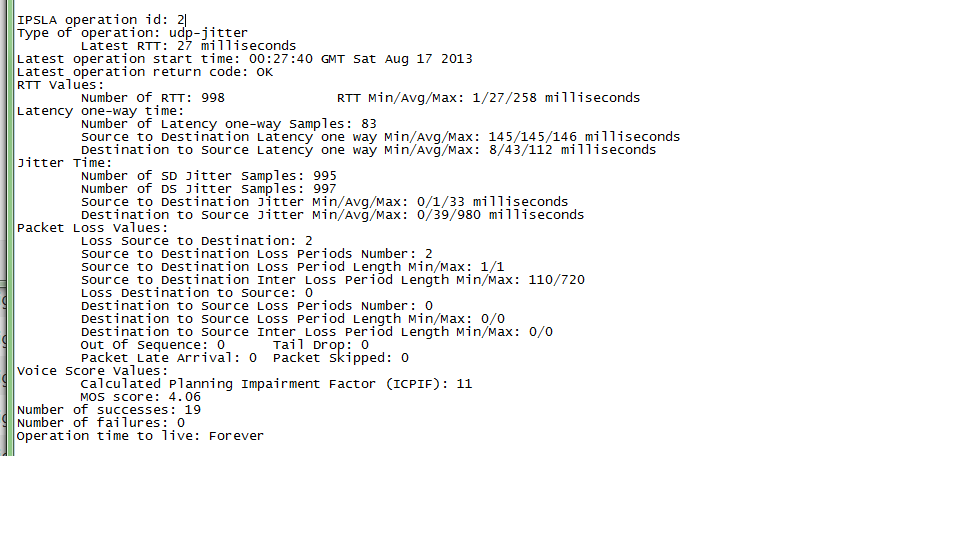- Cisco Community
- Technology and Support
- Networking
- Network Management
- IP SLA jitter issue
- Subscribe to RSS Feed
- Mark Topic as New
- Mark Topic as Read
- Float this Topic for Current User
- Bookmark
- Subscribe
- Mute
- Printer Friendly Page
- Mark as New
- Bookmark
- Subscribe
- Mute
- Subscribe to RSS Feed
- Permalink
- Report Inappropriate Content
08-16-2013 05:40 PM
Hi all,
I config the ipsla jitter to monitor the voip traffic between german and hk. However I get the following statistic that the SD and DS are unbalance. Could anyone know what the issue is ?

Thanks
Leung Che Man
Solved! Go to Solution.
- Labels:
-
Network Management
Accepted Solutions
- Mark as New
- Bookmark
- Subscribe
- Mute
- Subscribe to RSS Feed
- Permalink
- Report Inappropriate Content
08-18-2013 12:41 PM
The different values in SD and DS can be due to asymmetric paths between source and destination. So because the SD and DS the packets may be taking a different path, the values may differ, you need to check routing to verify it.
How jitter is calulated is the Cisco IOS source router consecutively sends multiple packets to the destination at ten millisecond intervals; if the network is operating optimally, the destination should receive them at ten-millisecond intervals. Delays (ie: queueing, or arriving through alternate routes) in the network can cause inter-packet arrival delay of greater or less than ten milliseconds.
Positive jitter implies that the packets arrived at intervals of more than ten milliseconds. If they arrive twelve milliseconds apart, then positive jitter is equivalent to two milliseconds. Negative jitter is computed similarly when the interval is smaller than originally encoded.
Greater value for positive jitter is undesirable for voice networks, and a jitter value of zero is ideal for delay-sensitive networks.
More details please check :
-Thanks
- Mark as New
- Bookmark
- Subscribe
- Mute
- Subscribe to RSS Feed
- Permalink
- Report Inappropriate Content
08-18-2013 12:41 PM
The different values in SD and DS can be due to asymmetric paths between source and destination. So because the SD and DS the packets may be taking a different path, the values may differ, you need to check routing to verify it.
How jitter is calulated is the Cisco IOS source router consecutively sends multiple packets to the destination at ten millisecond intervals; if the network is operating optimally, the destination should receive them at ten-millisecond intervals. Delays (ie: queueing, or arriving through alternate routes) in the network can cause inter-packet arrival delay of greater or less than ten milliseconds.
Positive jitter implies that the packets arrived at intervals of more than ten milliseconds. If they arrive twelve milliseconds apart, then positive jitter is equivalent to two milliseconds. Negative jitter is computed similarly when the interval is smaller than originally encoded.
Greater value for positive jitter is undesirable for voice networks, and a jitter value of zero is ideal for delay-sensitive networks.
More details please check :
-Thanks
- Mark as New
- Bookmark
- Subscribe
- Mute
- Subscribe to RSS Feed
- Permalink
- Report Inappropriate Content
08-20-2013 06:26 PM
Hi Vinod,
Thanks for your information. I will check with local customer for this issue.
cheers
Leung Che Man
Discover and save your favorite ideas. Come back to expert answers, step-by-step guides, recent topics, and more.
New here? Get started with these tips. How to use Community New member guide